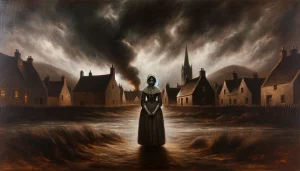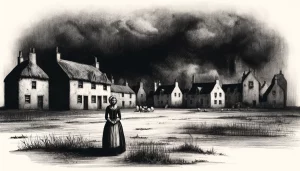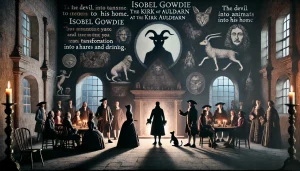The Confessions of Isobel Gowdie: The Witch of Auldearn
 Imagine living in a world where people believed in magic so strongly that they would accuse their neighbours of being witches. This was the world of Isobel Gowdie, a woman whose extraordinary confessions have fascinated historians for centuries.
Imagine living in a world where people believed in magic so strongly that they would accuse their neighbours of being witches. This was the world of Isobel Gowdie, a woman whose extraordinary confessions have fascinated historians for centuries.
In 1662, Isobel Gowdie, a Scottish woman, gave detailed confessions about her supposed life as a witch. Her stories included meetings with the Devil and transforming into animals. But were these tales true, or was there something else behind her confessions? This post will explore the intriguing life of Isobel Gowdie and the mysterious world she lived in.
The World of 17th-Century Witch Trials
The fear and superstition surrounding witchcraft were widespread in 17th-century Scotland. During this period, accusations of witchcraft were common, and many people, particularly women, were tried and executed for supposedly practicing dark magic. The witch hunts were fuelled by a mix of fear, superstition, and religious fervor, with communities often turning against individuals who were seen as different or threatening.
People in 17th-century Scotland believed that witches had the power to cause harm through supernatural means. They were thought to be in league with the Devil, using their powers to curse their neighbors, cause illnesses, or even manipulate the weather. These beliefs were often reinforced by religious authorities, who preached about the dangers of witchcraft and the necessity of rooting out witches to protect the community.
So Why Did People Believe in Witchcraft?
At the heart of these beliefs was a lack of scientific understanding. Natural phenomena that we can explain today, such as disease or weather patterns, were often attributed to supernatural causes. When something went wrong—a failed crop, a sudden illness, or unexpected bad weather—people looked for someone to blame. Superstition filled the gaps left by a lack of knowledge, and fear of the unknown drove communities to target those who were vulnerable or different.
Who Was Isobel Gowdie?
Isobel Gowdie lived in the small village of Auldearn in Scotland. Little is known about her early life, but in 1662,  she became infamous due to her detailed confessions of witchcraft. Her statements were unusually vivid and detailed, providing a rare glimpse into the beliefs and accusations of the time.
she became infamous due to her detailed confessions of witchcraft. Her statements were unusually vivid and detailed, providing a rare glimpse into the beliefs and accusations of the time.
Isobel’s confessions were remarkable not only for their detail but also for their fantastical content. She claimed to have met with the Devil in various forms, participated in witches’ sabbaths, and transformed into animals. Her vivid descriptions painted a picture of a world filled with dark magic and supernatural occurrences. This is what she said in one of her confessions:
“I met with the Devil in the shape of a black man, at the kirk of Auldearn, where he had a meeting with us all and invited us to his home. There, I was baptized by him, and we drank and danced. We were sometimes transformed into animals, such as hares or cats, to escape detection by our enemies.”
These confessions were likely obtained under duress, as was common in witch trials. However, the level of detail and the consistency of her stories have puzzled historians, leading to various interpretations.
Did You Know?
Isobel Gowdie’s confessions are some of the most detailed on record from that period. Unlike many accused witches, she provided vivid, elaborate stories that have intrigued historians and scholars for years.
Immediate Consequences
The exact fate of Isobel Gowdie is unknown. Records of her trial do not specify whether she was executed,  imprisoned, or disappeared from public view. What is clear is that her confessions had a significant impact on her community and contributed to the ongoing fear and persecution of supposed witches.
imprisoned, or disappeared from public view. What is clear is that her confessions had a significant impact on her community and contributed to the ongoing fear and persecution of supposed witches.
Historians have debated the meaning and motivation behind Isobel Gowdie’s confessions. Some believe they were the result of coercion and torture, common practices in witch trials. Others suggest she may have been suffering from a psychological condition that caused her to believe in her own stories. Alternatively, some argue that her confessions were a form of resistance or a way to gain control over her situation by manipulating her inquisitors with elaborate tales. Regardless of the true reason, her confessions remain a significant historical artefact, providing insight into the fears and beliefs of her time.
Isobel Gowdie’s confessions give us a unique window into the fears and beliefs of 17th-century Scotland. Whether or not her stories were true, they reflect a time when the line between reality and superstition was often blurred. As historian Ronald Hutton said, “Her confessions are a rich and detailed tapestry of the world of a supposed witch.”
Find Out More!
– The Witch-Hunt in Early Modern Europe by Brian P. Levack: A comprehensive look at the history of witch hunts across Europe.
– National Archives of Scotland’s Digital Collection: Explore original documents related to Scottish witch trials.
– Witches and Neighbours – The Social and Cultural Context of European Witchcraft” by Robin Briggs: Understand the broader social and cultural background of witchcraft accusations.
0 Comments